

On this month's Special Page:
The President of the Ghost Research
Society tells us about Spirit Photography
IN THE "SPECIAL PAGE" ARCHIVES:
Owl Goingback
Paul Tremblay
Joe R. Lansdale
Ramsey Campbell
John McLoughlin
Ray Garton
Jonathan Maberry
Spirit Photography: Real or Not?
Dale Kaczmarek tells us!
Ghost photographs at the bottom of this page, underneath the article.
Not since the early experiments of Sir William Crookes and other contemporary spirit photographers has so much attention and interest been devoted to spirit photography – the ability of capturing an elusive phantom image on photographic film. Science has come very far since those early camera and photographic techniques; yet, ordinary people continue to take strange and unusual images without realizing it.
The first spirit images were documented with old, antiquated devices. However, camera osbscuras, Latin for Dark Room, were the first such device used for picture taking. This device was simply a dark box with a hole in one end.
Today, many believe that spirit photography was discovered by William H. Mumler of Boston. One day in 1862, a Dr. Gardner was photographed by Mumler and on the plate appeared an image which Gardner identified as his cousin, who had died twelve years earlier. Later on Mumler faced possible prosecution for possible fraud, however there was insufficient evidence and he was acquitted.
Another early spirit photographer who got in trouble with the law was E. Buguet, a Frenchman who traveled to London in 1874 where he too began a career in spirit photography. Most of his photographs represented well-known personages. Many of his pictures were recognized by his clients, and even when he had been tried by the French Government and had admitted deception, there were those who refused to regard his confession as spontaneous and inclined to the opinion that he had been bribed by the Jesuits to confess to fraud of which he was innocent. He was imprisoned for one year and fined 500 Francs.
In his confession he stated that his spirit photographs were produced by double exposure. First he dressed up his assistants to play the part of the ghost, later he constructed a doll which, variously draped, served in a similar manner for the body of the ghost. This figure, and a large stock of heads were seized by the police at his studio.
Sir William Crookes was one of the greatest physicist of the century and was Elected Fellow of the Royal Society in 1863, Royal Gold Medal 1875, Davy Medal 1888, Sir Joseph Copley Medal 1904, knighted in 1897, Order of Merit 1910 and President at different times of the Royal Society, the Chemical Society, the Institution of Electrical Engineers, the British Association and the Society for Psychical Research. He discovered the element Thallium, invented the radiometer, spinthariscope and Crookes tube. He was fascinated with psychic phenomena and spirit photography. He was obsessed with the famous psychic D.D. Home and later became involved with séances and the manifestations of Katie King through psychic Florence Cook.
There were amazing images taken of the manifestation of Katie King and even though skeptics of the day said that those images did not rise to level of a spirit manifestation, they were indeed fascinating!
Most modern day spirit photographers employ more stringent safeguards to ensure that what they photograph is not explainable. However, the vast majority of spirit photographs come from ordinary people; someone who is simply photographing an innocent event such as a birthday party, social gathering, a vacation, wedding, graduation or just family events. Most images captured often aren’t seen by the naked eye but later show up in the finished product.
These images can vary from cloudy or misty formations, to streaks of lights, balls, shadowy figures, semi-transparent images or full-bodied apparitions. While a great many of these images can be explained away, many cannot. It’s those images that don’t have a readily identifiable explanation that are most intriguing to the ghost researcher.
Modern 35mm cameras can photograph with shutter speeds of 1/1000th of a second. That’s much quicker than the blink of an eye. It’s in that fraction of a second; something may have been captured that was only visible for that sort space of time that our physical eye did not have the time to recognize it as an image, sending the pattern through our retina and then to the brain. In other words, we didn’t see it but the camera did. Our eyes are like motion picture cameras in that we take in video and moving images. The camera on the other hand can freeze that moment of time into a single frame that can later be examined and analyzed. This is again where that old adage comes from, “I didn’t see anything but the camera did!”
The shortcomings of a 35mm camera is that you have to develop the film before you can see if you captured anything while today’s digital cameras give you that instant gratification. What you see is what you get. Digital images are just a series of 1’s and 0’s while a 35mm camera will generate a negative that you can physically hold in your hand. Negatives cannot be manipulated like digital images can today. That leads into the possibility of deception and fraud especially with ghost applications.
35mm cameras control light and images that strike the emulsion layer of the film through a variety of ways. The aperture of the lens can be opened and closed, allowing more or less light from entering through the lens. This is known as F-stops. An F-22 allows more light than an F-8 setting. The shutter speed is also a big factor. Shutter speeds from 1/1000th of a second, down to manually opening and keeping the shutter open allows light to enter at the selected shutter speed. Today’s point and shoot cameras automatically select both F-stops and shutter speed so all one has to do is “point and shoot.” This method is also how a lot of digital cameras operate.
So what does one do when they believe that they have photographed a ghost? You should always look at environmental conditions before you jump to conclusions. First, what kind of image did you capture? Was it a misty form, strange lights, balls of lights, semi-transparent form or something else?
I have been analyzing spirit photographs for the past 35 years and have literally seen thousands of alleged ghost images. Most of these however had natural explanations. This is how I go about analyzing images.
First, I request that all relevant information about the picture taking process accompany the alleged ghost image. This could be weather conditions, temperature, humidity, dusty or wet conditions, type of camera (and film) used and why the picture was taken in the first place. Without this information, a thorough analysis cannot be completed. I also request that “orbs” taken with digital cameras not be submitted due to the vast amount of natural explanations such as dust particles, bug and insects, humidity or water droplets in the air or even digital flaws. Digital flaws producing “orbs” are usually caused when the camera attempts to produce an image, often in very low-light situations, and is not completely successful often creating an orb of light that can be translucent or visually opaque. These are areas of the image that are a lack of pixilation when the camera simply doesn’t “fill in” the necessary pixels and what you see is an orb. Now, if you actually “see” the orb with the naked eye or the orb is generating its own light source, those are very interesting and should be submitted. Approximately 98% of orbs can be explained away.
Since I have examined so many images, I am often able to quickly debunk or come up with a natural explanation quickly based on my expertise and the information submitted. There are some however that defy natural explanations and may even be actual proof of a discarnate entity.
Since most images today are submitted via digital technology, I use specific software to examine these photographs. A digital camera gathers light energy through a lens and focuses it on a CCD, which converts it into electrical impulses. These signals are fed into a microprocessor where they are sampled and transformed into digital information. This numerical data is then stored and usually transferred later onto a computer where the image can be viewed. After the CCD converts light into an electrical signal, it is sent to the image digitizer. The digitizer samples areas of light and shadow from across the image, breaking them into points or pixels. The pixels are next quantized – assigned digital brightness values. For black and white, this means placing the pixel on a numerical scale that ranges from pure white to pure black. In color imaging, the process includes scales for color resolution and chromatic intensity.
Unfortunately digital images are easier to manipulate using Adobe Photoshop or ghost applications where one can convincingly insert a ghostly image and make it look quite real. There are ways to pick up these manipulations though. I use a program called JPEGsnoop. This freeware program will alert the user if the picture has been altered. JPEGsnoop is a free Windows application that examines and decodes the inner details of JPEG, MotionJPEG AVI and Photoshop files. It can also be used to analyze the source of an image to test its authenticity. This is accomplished by examining the EXIF data relevant with all digital images produced by digital cameras.
EXIF or exchangeable image file format is a standard that specifies the formats for images, sound, and ancillary tags used by digital cameras, scanners and other systems handling image and sound files recorded by digital cameras. Once a picture is taken, the camera assigns EXIF data to the file. If the image has been processed or edited, the program will tell you that due to the fact the image is not original. In other words, it was most likely taken, downloaded, altered and then resaved. The program will pick that up and let the user know that the image has high probability of being edited in some way. If the program used for editing is one that the program recognizes, it will list that program used for possibly altering the image.
Ghost applications are good examples of how an image can be altered. The internet is full of such applications that were created for fun purposes and not necessarily for those who might wish to claim that image is an authentic ghost capture. I have been inundated with these ghost apps but they are very easy to spot with the naked eye or through JPEGsnoop. Another way I use is to Google the internet for ghost applications screen shots. Many times I am able to match an image sent in for analysis with a perfect match from a ghost application screen shot. Here is one example that initially flooded the internet. I have dozens of pictures with this same little girl wearing the same striped dress. It’s a fake!
Camera straps are another picture that is sent in for my opinion. These are very easily identifiable because they all look the same. The strap is very bright often because they are the closest object to the camera and the flash. Therefore they have a “washed-out” effect and are over-exposed due to its proximity to the camera’s flash unit. Secondly, they always have a serrated edge, much like a steak knife. Look at your camera’s strap and you’ll see what I’m referring to. Most camera straps hang from the left and right of the lens. These images are created when one tilts the camera 90 degrees to the left or right. The strap then will dangle in front of the camera and be photographed as a “Vortex.” It is not and is very explainable. Sometimes the camera’s wrist strap is only attached to the right of the lens. When this strap is photographed it often appears to be forming from the right side of the frame and horizontal in orientation. So this will never happen to you, try removing the strap or keep the cameras hanging around your neck. This way the strap will never appear in frame.
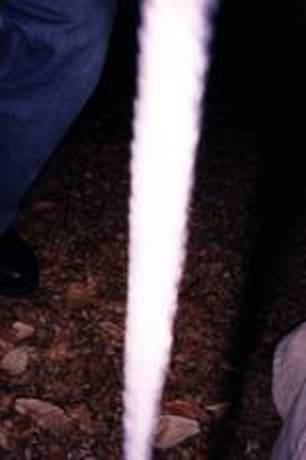
Mist or fogs can be a variety of natural explanations including cigarette smoke. It is for this reason that I don’t allow smoking during investigations. Cigarette, even though invisible, can be illuminated by a flash. Many pictures taken outdoors during the winter months can simply be the difference in temperature between the outside air and one’s breath illuminated by the flash.
There are so many other examples of accidental spirit photography including people walking into the frame of the camera. When this happens they can appear to be semi-transparent because the camera sometimes cannot “freeze” the motion of real people entering and exiting the frame of the picture.
Len glare can create hexagonal shaped images due to the light reflecting off the six-sided lens of the camera. These images can appear to have been broken into the various colors of light spectrum because the lens is somewhat like a prism.
Obstructions can be caused by anything that comes in between the camera and the subject of the picture taking process. When using a flash the obstruction appears bright white and when no flash is used, just the opposite occurs, the obstruction is very dark.
And my favorite is pareidolia, matrixing or simulacra which is just the human mind attempting to make something out of a picture that doesn’t truly exist. It can be compared to seeing ink spots on a piece of paper or clouds in the sky. One person will see something totally different then the next person unless, of course, they are told what to look for, then most will see it.
I would like to close and invite those who truly believe that they have photographed something unusual to email those images along with all the relevant information to dale@ghostresearch.org and also visit my website www.ghostresearch.org and check out the spirit photography page for more information about what I require to analyze an image. Important!! Remember that you are asking for MY opinions so please don’t get offended if my analysis doesn’t jive with what you believe you have captured. You don’t have to agree with me but we can disagree with civility.
You can also purchase a copy of my book Field Guide to Spirit Photography directing from my website or other online locations.
Having investigated over 4100 locations in the past 45 years in the field and having seen and analyzed thousands of pictures in the past 35 years, I find myself uniquely qualified to find the truth. During my many investigations with the Ghost Research Society, I have had many paranormal experiences; some that were unexpected. I will see that I have never been frightened by anything nor I have run screaming from a location like so many of those reality television ghost shows. I have seen my share of ghosts, shadow figures and have had a few actual interactions where I have been touched or poked. These were unique experiences and something that I thrive for when investigating spooky places. During these investigations, we have uncovered lots evidence; EVPs, videos and pictures. That evidence can be found at www.ghostresearch.org/Investigations.
I also run Excursions Into the Unknown, Inc. the longest running ghost tour in the Chicagoland area since 1982. I am CEO of Ghost Research Society Press, producing fine books on the paranormal in 2004. I lecture on a wide variety of topics and have been on many television, radio, newspaper articles and internet radio programs.
GHOST PHOTOS BELOW
Explanations underneath each photo
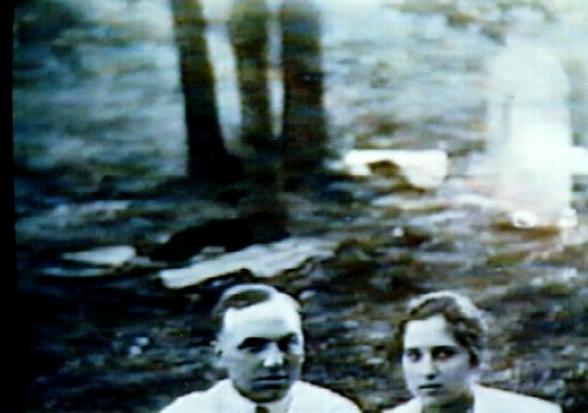
Not too much is known about the specifics of this photograph except the couple are now both deceased. To the right of the tree in the upper right-hand corner is a definite misty shape in the form of a human being.
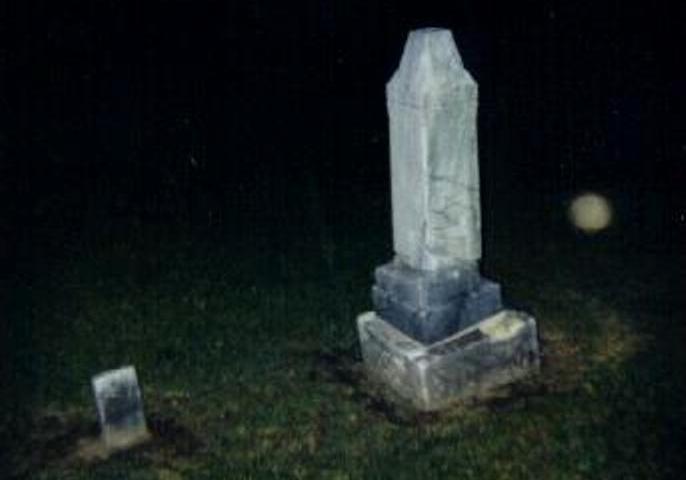
A floating orb in Mt. Thabor Cemetery, northern Illinois. This picture was taken with a Polaroid camera at about 10pm and shows a small orb apparently floating just above the ground near an old marble monument. The camera was pointed away from the roadway and any reflective surfaces.
We can't be 100% sure that this wasn't a natural phenomena such as a bug, insect or dust particle. 99.9% of orb photographs have natural explanations.
Photo by Dale Kaczmarek, June 1998.
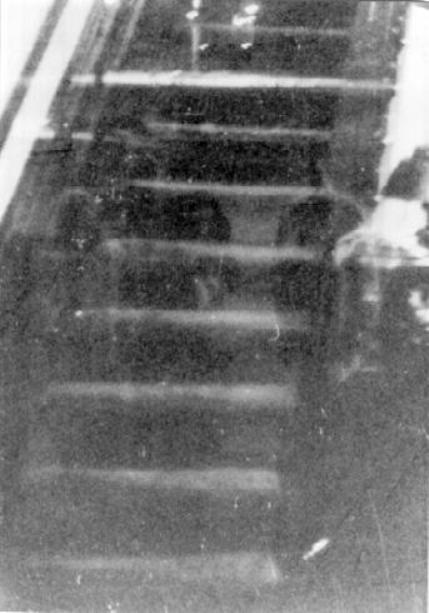
A black and white infrared picture taken at Hull House in downtown Chicago, Illinois by Dale Kaczmarek in November of 1980. This is enlarged blowup of the interior staircase of this most haunted house in Chicago. There was nothing visible to the naked eye when the photograph was taken but what appears are four distinct shadowy monk-like figures standing on the bottom four or five steps. The one directly in the middle appears to be dressed in monk's habit with his two hands together in prayer. There are two other figures to the left of the center monk and one to the right superimposed on the banister which apparently has no head!
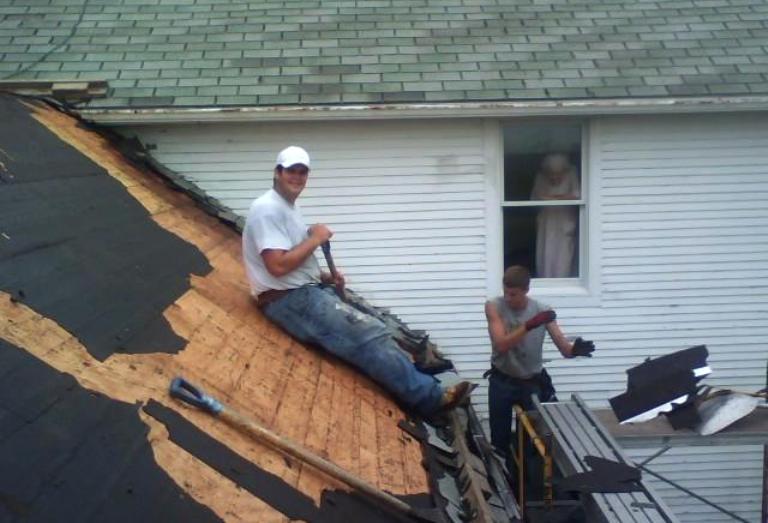
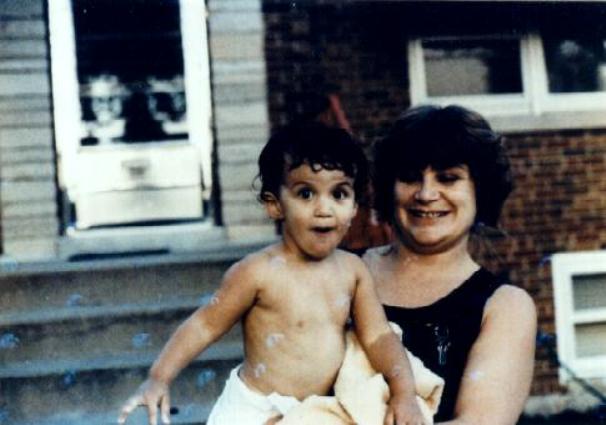
This picture was taken by the husband of the woman in the picture on a sunny afternoon with ordinary print film. They had just moved into their new home in Chicago, Illinois. In the window to the left of them clearly shows a older woman with her hair put up in a bun and a bulldog next to her. There was no one in the house at the time of the picture taking.
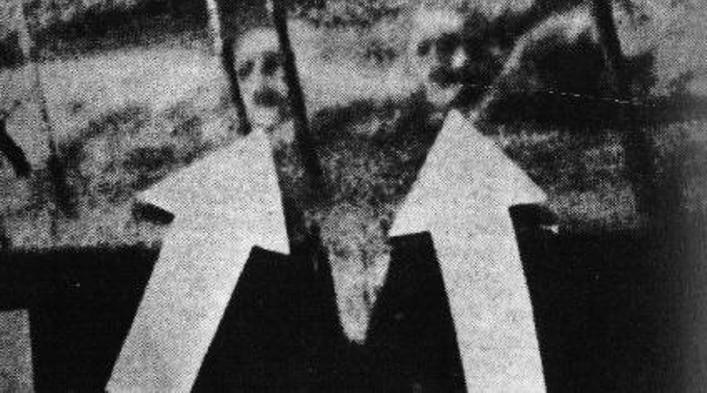
The case of the SS Watertown is a classic example of what many believe to be an authentic ghost photograph. The story, as recounted by the eminent and long-time director of the American Psychical Institute, Dr. Hereward Carrington, and as detailed in the house magazine of the shipping company, told of the tanker, SS Watertown making its way through the Pacific Ocean in December 1924. Seaman James Courtney and Michael Meehan were assigned to clean out a cargo tank. While doing this task they were overcome by gas fumes and died before help could reach them. Following the tradition of the sea, their bodies were committed to the ocean on December 4th. The following day, just before dusk, the entire ship was in uproar when the heads of the two dead seamen were clearly seen on board ship and, later, in the sea. Thereafter the ghost faces were frequently seen. A snapshot was taken and the camera, with film intact and untouched inside, was handed to Captain Keith Tracy for safekeeping. On reaching port in New Orleans the Captain handed the camera over to officials of the Cities Services Company and they sent it directly to their New York office, where the film was developed and printed by a commercial photographer, and there were the heads of Courtney and Meehan, exactly as they had been seen on board ship!
Go to the Ghost Research Society HERE
About Dale Kaczmarek

Dale Kaczmarek is an investigator and President of the Ghost Research
Society since it's founding in 1977 and author of "Windy City Ghosts","Windy City Ghosts II", "A Field Guide to Spirit Photography","Illuminating the Darkness: The Mystery of Spooklights", "Field Guide to
Ghost Hunting Techniques" and "Field Guide to Haunted Highways and Bridges"
Ghost Research Society http://www.ghostresearch.org
Homepage of the Ghost Research Society Press; publishing books on the paranormal and mysterious phenomena since 2004.http://www.ghostresearch.org/press
Ghost Research Society & Excursions Into the Unknown, Inc. PO Box 205 Oak Lawn, IL. 60454-0205 (708)425-5163 http://www.ghostresearch.org/tours